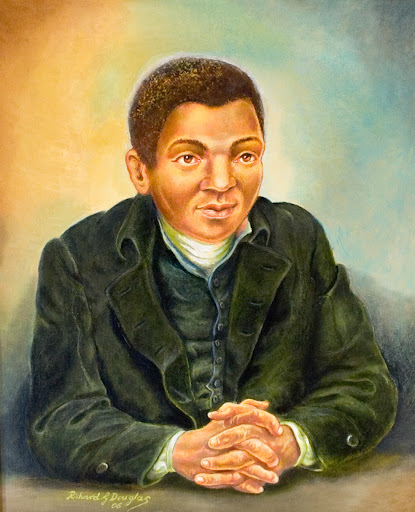As a nod to our new Vice President, Mike Pence, the former Governor of the State of Indiana, we present something not widely known about the origin of the nickname of Indiana “The Hoosier State.”
There are many ideas about the origins of the nickname of the state of Indiana. All of them are wrong if they don’t mention one of the greatest pastors of the 2nd Great Awakening, Harry Hoosier.
When Indiana was still a territory there was a need for pastors to go from town to town establishing churches. Reverend John Wesley, the founder of the Methodist church, was one such person who would establish a church then move to the next town to establish another.
“Black Harry” Hoosier was another.
The following is an excerpt from the Wallbuilders.com article “Black History Issue 2005.” The article was written by David Barton in January 2005

Harry Hoosier (or Hosier) portrait by Richard Douglas
The Rev. “Black Harry” Hoosier (or Hosier) 1750-1810
Harry Hoosier was born a slave in North Carolina, but toward the end of the American Revolution he obtained his freedom, converted to Methodism, and became a preacher. In 1781, he delivered a sermon in Virginia entitled “The Barren Fig Tree” – the first recorded Methodist sermon by an African American [from the Gospel of Luke 13: 6-9]*. Despite the fact that Hoosier was illiterate, he became famous as a traveling evangelist and was considered one of the most popular preachers of his era. In fact, after hearing Harry preach in and around Philadelphia, Dr. Benjamin Rush (1745-1813), a signer of the Declaration of Independence and an evangelical Christian, declared that accounting for his illiteracy, Hoosier was “the greatest orator in America.”
Early in his ministry, Harry became a close associate of Bishop Francis Asbury (1745- 1816), the “Founding Father of the American Methodist Church.”
(In 1771, Asbury – an Englishman – heard an appeal from John Wesley for preachers to go to America to “spread the Word.” Asbury responded, and during the next four decades he preached almost 20,000 sermons and rode over a quarter of a million miles across America – on horseback! When Asbury first arrived, there were only 550 Methodists in America, but by the time of his death in 1816, there were 250,000 – and 700 ordained Methodist ministers. In 1924 when a statue of Bishop Asbury was erected in Washington, DC, President Calvin Coolidge declared of Asbury that “He is entitled to rank as one of the builders of our nation.”)
Hoosier and Bishop Asbury traveled and preached together, but Bishop Asbury (who drew huge crowds) remarked that Harry drew even larger crowds than he did! In fact, the Rev. Henry Boehm (1775-1875) reported: “Harry. . . . was so illiterate he could not read a word [but h]e would repeat the hymn as if reading it, and quote his text with great accuracy. His voice was musical, and his tongue as the pen of a ready writer. He was unboundedly popular, and many would rather hear him than the bishops.” Harry also traveled and preached with other popular bishops of that era, including the Rev. Richard Whatcoat (1736- 1806), the Rev. Freeborn Garretson (1752-1827), and the Rev. Thomas Coke (1747-1814). The Rev. Coke said of Asbury that, “I really believe he is one of the best preachers in the world. There is such an amazing power that attends his preaching . . . and he is one of the humblest creatures I ever saw.”
Hoosier ministered widely along the American frontier and is described by historians as “a renowned camp meeting exhorter, the most widely known black preacher of his time, and arguably the greatest circuit rider of his day.” However, he was unpopular in the South for two reasons: first, frontier Methodists such as Hoosier tended to lean Arminian in their theology, contrasted with the denominations of the South that were largely Calvinistic (e.g., Presbyterians, Reformed, Episcopalians, Baptists, etc. – yes, the Baptists of that day were largely Calvinistic!); second, Methodists were outspoken against slavery whereas the majority of the South supported slavery. Therefore, southern groups such as the Virginia Baptists came to use the term “Hoosiers” as an insulting term of derision that they applied to Methodists like Black Harry Hoosier, meaning that they were anti-slavery in belief and Arminian in theology.
Fisk University history professor William Piersen believes that this is the source of the term “Hoosier” that was applied to the inhabitants of Indiana. Piersen explains, “Such an etymology would offer Indiana a plausible and worthy first Hoosier – ‘Black Harry’ Hoosier – the greatest preacher of his day, a man who rejected slavery and stood up for morality and the common man.”
Noted African American historian Carter Woodson reported the words of early Methodist historian John Ledman in describing the closing chapter of Harry Hoosier’s life:
After he had moved on the tide of popularity for a number of years . . . he fell by wine – one of the strong enemies of both ministers and people. And now, alas! this popular preacher was a drunken ragpicker in the streets of Philadelphia. But we will not leave him here. One evening, Harry . . . determined to remain there until his backslidings were healed. Under a tree he wrestled with God in prayer. Sometime that night, God restored to him the joys of his salvation [Psalm 51:12]. . . . About the year 1810, Harry finished his course. . . . An unusually large number of people, both white and colored, followed his body to its last resting place, in a free burying ground in Kensington [near Philadelphia].
The Rev. Harry Hoosier was used by God to draw thousands of Americans to Christ during the early decades of the Second Great Awakening.
* our addition to the article.
